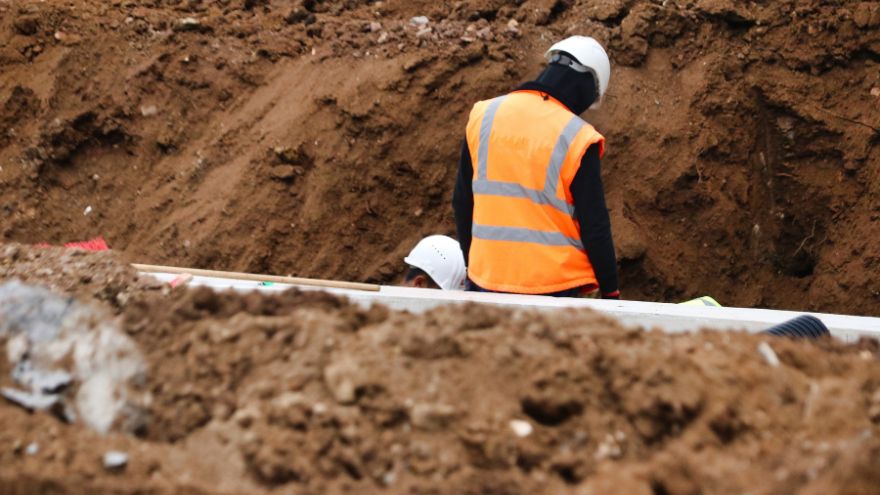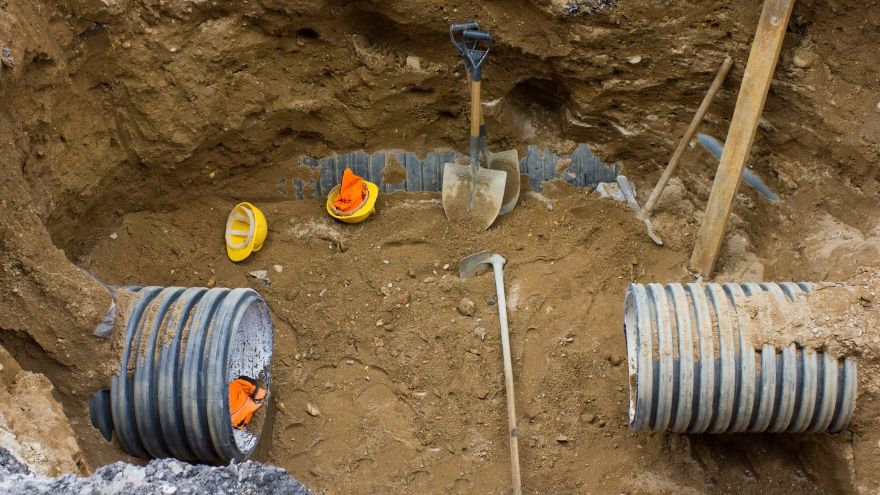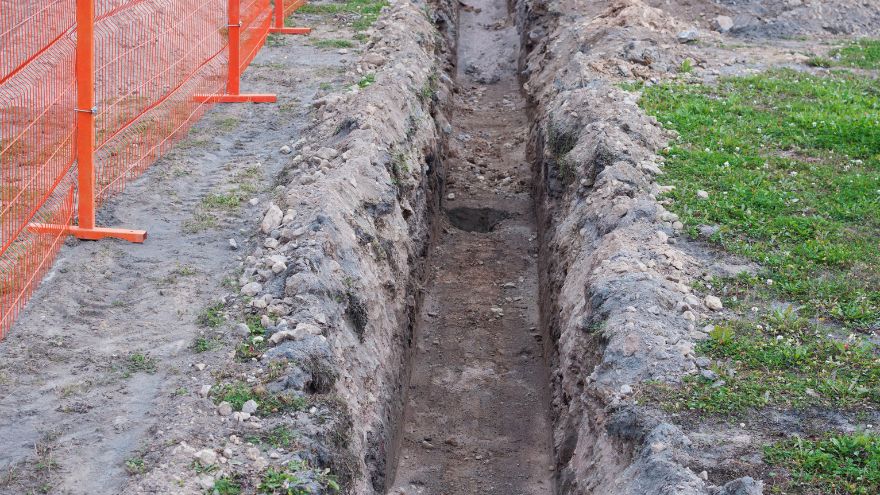Contrary to the prevailing belief, the so-called "digging ditches" requires not only good muscles, but also specific and detailed knowledge. It is not an art to make a hole in the ground - you also need to be able to adjust its depth and filling in terms of what is to be placed in the hole. How to prepare trenches for power cables? Answers below!

From this article you will learn:
- at what depth should cables be buried;
- how far from certain underground facilities they must be located;
- what effect on the tension at the depth of the excavation.
At what depth should the power cable be buried?
As in virtually every case involving a construction investment during which work is carried out on supplying electricity, the depth of cable installation is regulated by relevant standards . In this specific situation, the conditions are specified in the N-SEP-E-004 standard, which in 2014 replaced the previously applicable PN-76/E-05125 standard. So much theory, but what does it mean in practice?
 The depth of laying cables in trenches depends on several factors , such as:
The depth of laying cables in trenches depends on several factors , such as:
- rated voltage of cables;
- characteristics of the soil in which the excavation is carried out;
- classification of land in terms of its intended use.
So one by one.
- Cables powering traffic/road signals, lighting poles, lighting road signs and advertising elements with a rated voltage of up to 1 kV should be laid at a depth of 50 cm under the sidewalk or bicycle path.
- Cables with a rated voltage of up to 1 kV outside agricultural land - at a depth of at least 70 cm. For voltages 1-30 kV this depth increases to at least 80 cm.
- Cables laid on agricultural land must be buried in the ground to a minimum depth of 90 cm, and in any case where voltages above 30 kV are involved, the depth is at least 1 m.
- If it is necessary to install several such cables, they must be separated vertically by no less than 70 cm .
Check the offer of PVC-insulated earth cables up to 1 kV
There is also an alternative in the form of additional cable covers and a smaller depth , but this solution is only possible when conditions (e.g. environmental or geodetic) do not allow for deep enough excavations.
As for the soil characteristics, the standard specifies the need to lay the cable at the bottom of the trench in the case of sandy soil. If the ground is not uniform, it is recommended to place at least a 10-centimeter layer of sand at the bottom of the trench on which the cable is laid (maintaining the depths specified above). The cable is then covered with a second layer of sand, also at least min. 10 cm. The top layer may be native soil. Instead of sand, you can use a mixture of sand and cement (in a ratio of at least 13:1) or an alternative mass, e.g. bentonite, although it should be a certified product. Regardless of whether it is sand or a mixture, it is important to compact the layer after backfilling to a density of min. 1.6 t/m 3 to ensure appropriate thermal resistivity.
The cable line route must also be marked with a plastic cable net or foil , with a permanent color appropriate to the rated voltage of the cable. At voltages up to 1 kV it is blue, above 1 kV it is red. The mesh or foil should be placed and covered not less than 25 but not more than 35 cm above the cable. For intersections, line markings should be at the same depth. When laying the grounding hoop in the same trench in which the cable is laid, the hoop should be buried in the bottom of the cable trench to a depth of at least 10 cm.
Check the offer of earth cables with XLPE insulation up to 1 kV
Power cable - how far from the plot boundary?
 According to applicable regulations, cables should be placed at a distance of at least 50 cm from the border of the plot where the excavation is being made. On the one hand, this gives a margin for the construction of a fence, but on the other hand, it is necessary to take into account potential buildings that may be built near the planned cable line. The boundaries of your own plot are decisive - consultations with neighbors and assessment of the distance of any objects from the excavation that are located on other people's properties are not necessary.
According to applicable regulations, cables should be placed at a distance of at least 50 cm from the border of the plot where the excavation is being made. On the one hand, this gives a margin for the construction of a fence, but on the other hand, it is necessary to take into account potential buildings that may be built near the planned cable line. The boundaries of your own plot are decisive - consultations with neighbors and assessment of the distance of any objects from the excavation that are located on other people's properties are not necessary.
However, they are important, perhaps even more important, to maintain the distance of cables from other underground devices . They are as follows:
- in the case of water supply, sewage, heat and gas pipelines with non-flammable gases: for cables with voltage up to 30 kV min. 25 cm plus pipeline diameter vertically at the intersection and horizontally at the approach, for cables with voltage 30-110 kV, each time min. 50 cm plus pipeline diameter;
- in the case of pipelines with flammable gases and liquids: not less than above, but this should be agreed with the owner of the pipeline;
- in the case of tanks with flammable gases and liquids : intersections are not possible; horizontally when approaching min. 200 cm (up to 30 kV) and 250 cm (30-110 kV), but for higher voltages (30-110 kV), details should be agreed with the owner of the device;
- for parts of underground overhead lines : crossings are not possible; horizontally when approaching min. 40 cm (up to 30 kV) and 100 cm (30-110 kV);
- in the case of walls of buildings and other structures : intersections are not possible; horizontally when approaching min. 50 cm (up to 30 kV; shorter distance allowed provided that surrounding shields are used and the exception is agreed with the facility user) and 100 cm (30-110 kV);
- in the case of devices for protecting buildings against lightning : in accordance with the requirements of the PN-EN 62305 standard, which regulates issues related to lightning protection of buildings.
Check the offer of medium voltage earth cables up to 30 kV
Which YAKXS cable should I choose?
 Let's say at the beginning that the world of cables does not start or end with YAKXS cables . This marking covers cables with high parameters (including 90° C maximum allowable long-term temperature and 250° C maximum cable temperature under short circuit conditions), with cross-linked polyethylene insulation, but with aluminum conductors, which is not suitable for all installers. . Some people, by definition, reject such products in favor of equivalents equipped with copper conductors, and these are available under the YKXS mark. In addition, the parameters typical of XS type cables may sometimes exceed the requirements of a given investment - when it comes to, for example, the distribution of garden lighting, products such as YKY cable (copper) or YAKY cable (aluminum) , with PVC insulation and lower operating temperature margins, with will certainly prove to be completely sufficient. As in many other areas of life, casting pearls before swine is inadvisable - cables from the "good enough" category will certainly turn out to be... good enough .
Let's say at the beginning that the world of cables does not start or end with YAKXS cables . This marking covers cables with high parameters (including 90° C maximum allowable long-term temperature and 250° C maximum cable temperature under short circuit conditions), with cross-linked polyethylene insulation, but with aluminum conductors, which is not suitable for all installers. . Some people, by definition, reject such products in favor of equivalents equipped with copper conductors, and these are available under the YKXS mark. In addition, the parameters typical of XS type cables may sometimes exceed the requirements of a given investment - when it comes to, for example, the distribution of garden lighting, products such as YKY cable (copper) or YAKY cable (aluminum) , with PVC insulation and lower operating temperature margins, with will certainly prove to be completely sufficient. As in many other areas of life, casting pearls before swine is inadvisable - cables from the "good enough" category will certainly turn out to be... good enough .
We are aware that our guidelines are just the tip of the iceberg, but if we want to discuss in detail all aspects of excavating for power cables, we should include the standard here in a downloadable version. However, we believe that even these general guidelines will prove helpful and sufficient in many simple cases, and if it is necessary to seek more professional knowledge, they will be a good contribution to deepening it . Either way, we recommend ourselves from the product side!
Power cables in the Onninen offer – product overview
- YAKXS-ŻO 5X16 RE/SE 1KV HD power cable - core class: class 1 = single-wire; coating/insulation color: black; concentric vein: none; core material: aluminum; number of veins: 5; acidity class according to EN 13501-6: none; approximate outer diameter: 19.2 mm; rated voltage U0: 0.6 kV; reaction to fire class according to EN 13501-6: eca; outer shell material: polyvinyl chloride (PVC);
- YAKY 1x120 RMC 1kV energy cable - YAKY 1x120RMC 1kV earth energy cable type G-006595 reel made of multi-wire aluminum conductors, with PVC insulation and sheath; used to supply electricity to low voltage receivers ;
- YAKY 4x35 SE 1kV energy cable - conductors: aluminum; according to PN-88/E-90160
the shape of the veins is determined by the letters:
- class 1 conductors: round (RE), sector (SE);
- class 2 veins: circular thickened (RMC), sector-shaped (SM);
application: for the transmission of electricity; l power lines run in the air, inside and outside rooms, in cable ducts and laid directly in the ground ; - YAKY 4x150 SE 1kV energy cable - YAKY 4x150SE 1kV earth energy cable type G-006619, reel, made of sector aluminum conductors, with PVC insulation and coating; used to supply electricity to low-voltage receivers and to power equipment in industrial plants ;
- YAKXS power cable 4x120 SE 1kV /500m/ - conductors: aluminum; according to PN-88/E-90160, the shape of the veins is determined by the letters:
- class 1 conductors: round (RE), sector (SE);
- class 2 conductors: sector (SM);
insulation: cross-linked polyethylene (XS); filling: PVC or unvulcanized rubber (w); coating: PVC (Y) or polyethylene (X); insulation colors:
- 1-wire: as agreed;
- 4-wire: green-yellow, black, blue and brown or black, blue, brown, black;
the smallest allowable bending radius of cables when laying is equal to 15 times the outer diameter of the cable ; the maximum allowable temperature of working conductors is 90° C; the maximum allowable short-circuit temperature is 250° C; application: for the transmission of electricity; can be placed in the ground.